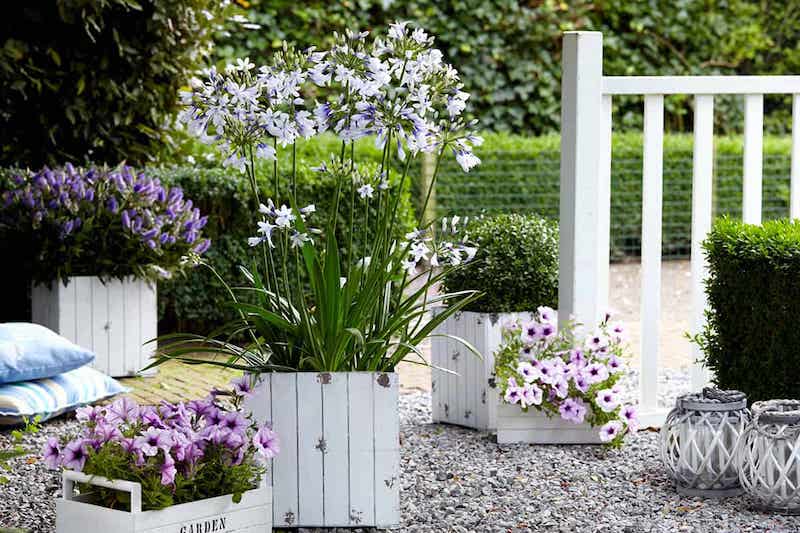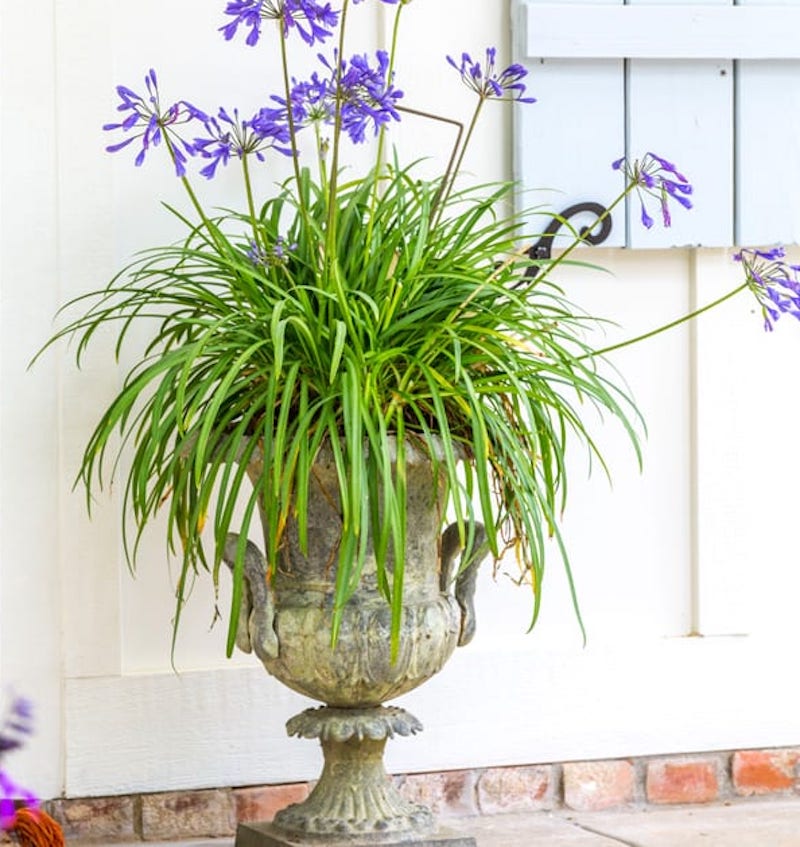Agapanthus is well suited to growing in containers. These perennials make excellent ‘thrillers’ in container combinations and also lovely solitary plantings. Because they are only hardy in zones 7 – 10, many people choose to grow them in pots, so they can be safely and easily overwintered indoors. The planters can be placed in any sunny location, lending a modern, bright look to any patio, balcony, deck, or porch in the summer. In cooler climates, the pots can be brought indoors and set near a sunny window.

Planting Agapanthus in Pots
The best time to pot up your agapanthus is in the spring or fall. Make sure all risk of frost has passed and find a sunny spot that receives 6 – 8 hours of direct sun. In hot southern climates, place the container where it will receive some afternoon shade. The pot should be at least 12 inches in diameter for a solitary planting or larger for plant combinations. Make sure the pot has large draining holes, as agapanthus does not tolerate wet feet. In addition, select a frost-resistant pot if you plan on overwintering your agapanthus outdoors.
Best Soil For Agapanthus in Pots
Use a light, well-drained potting mix to plant your agapanthus. You can topdress the container with a light layer of compost to conserve moisture. Do not add rocks or bark to the bottom of the pot, as these materials impede drainage. Agapanthus will not tolerate waterlogged soil.
Caring For Agapanthus in Planters
Interestingly, a potted agapanthus performs best when it is rootbound. When the roots fill out the container, this plant tends to bloom better and produce less foliage. You can divide rootbound plants every 4 – 5 years by taking out the plant and cutting the rhizome into sections with a sharp knife.

Watering Agapanthus in Pots
A potted agapanthus should be watered regularly to keep the soil from drying out completely. Use your finger to test if the top inch of the soil feels moist. If not, give the pot a good soak to saturate the soil. You will need to water more regularly during hot, dry periods. In general, containers need to be watered more frequently than in-ground plantings because the soil in pots dries out more quickly.
Fertilizing Agapanthus in Pots
Potted agapanthuses bloom best with light fertilizing during the growing season. Be careful not to overdo it, as overfertilization causes leggy growth. Use an organic, all-purpose formula at half strength to infuse a steady supply of nutrients in the soil. Reduce fertilizing in the fall to allow the plants to rest over the winter.
Winter Care For Agapanthus in Pots
When growing agapanthus in cooler climates (below zone 7), bring your pot indoors for the winter. Set it in a sunny window and reduce watering to around once a month to let the plant rest. Pots can be brought back outdoors in the spring once the risk of frost has passed. In warmer climates, a potted agapanthus can stay outdoors in the winter; however, make sure the container is weather resistant and won’t crack during a hard freeze.
Growing Agapanthus Indoors
Agapanthus can be grown easily indoors with sufficient light. Place the pot in a bright spot, preferably in a window facing south or southwest. Water the pot when the top inch of soil feels dry to the touch, which is approximately once a week during the growing season. Allow the plant to rest in the winter by reducing the watering and fertilizing frequency.
 |
Author Jessica Mercer - Published 6-29-2022 |
